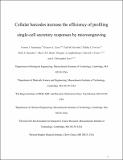| dc.contributor.author | Gierahn, Todd Michael | |
| dc.contributor.author | Forcier, Talitha L. | |
| dc.contributor.author | Brefo, Mavis S. | |
| dc.contributor.author | Yamanaka, Yvonne J. | |
| dc.contributor.author | Szeto, Gregory | |
| dc.contributor.author | Arnold, Kelly B. | |
| dc.contributor.author | Lauffenburger, Douglas A | |
| dc.contributor.author | Irvine, Darrell J | |
| dc.contributor.author | Love, John C | |
| dc.date.accessioned | 2013-07-26T15:15:15Z | |
| dc.date.available | 2013-07-26T15:15:15Z | |
| dc.date.issued | 2012-12 | |
| dc.identifier.issn | 0003-2700 | |
| dc.identifier.issn | 1520-6882 | |
| dc.identifier.uri | http://hdl.handle.net/1721.1/79706 | |
| dc.description.abstract | We present a method that uses fluorescent cellular barcodes to increase the number of unique samples that can be analyzed simultaneously by microengraving, a nanowell array-based technique for quantifying the secretory responses of thousands of single cells in parallel. Using n different fluorescent dyes to generate 2n unique cellular barcodes, we achieved a 2n-fold reduction in the number of arrays and quantity of reagents required per sample. The utility of this approach was demonstrated in three applications of interest in clinical and experimental immunology. Using barcoded human peripheral blood mononuclear cells and T cells, we constructed dose–response curves, profiled the secretory behavior of cells treated with mechanistically distinct stimuli, and tracked the secretory behaviors of different lineages of CD4+ T helper cells. In addition to increasing the number of samples analyzed by generating secretory profiles of single cells from multiple populations in a time- and reagent-efficient manner, we expect that cellular barcoding in combination with microengraving will facilitate unique experimental opportunities for quantitatively analyzing interactions among heterogeneous cells isolated in small groups (2–5 cells). | en_US |
| dc.description.sponsorship | Howard Hughes Medical Institute (Investigator) | en_US |
| dc.description.sponsorship | National Institute of Allergy and Infectious Diseases (U.S.) (Grant 1R56AI104274) | en_US |
| dc.description.sponsorship | National Institute of Allergy and Infectious Diseases (U.S.) (Grant 1U19AI089992) | en_US |
| dc.description.sponsorship | National Institute of Allergy and Infectious Diseases (U.S.) (Grant 5U01AI068618) | en_US |
| dc.description.sponsorship | National Science Foundation (U.S.) (Fellowship) | en_US |
| dc.description.sponsorship | Massachusetts Institute of Technology (Collamore-Rogers Fellowship) | en_US |
| dc.description.sponsorship | Ragon Institute of MGH, MIT and Harvard | en_US |
| dc.description.sponsorship | W. M. Keck Foundation | en_US |
| dc.language.iso | en_US | |
| dc.publisher | American Chemical Society | en_US |
| dc.relation.isversionof | http://dx.doi.org/10.1021/ac302264q | en_US |
| dc.rights | Article is made available in accordance with the publisher's policy and may be subject to US copyright law. Please refer to the publisher's site for terms of use. | en_US |
| dc.source | Prof. Love via Erja Kajosalo | en_US |
| dc.title | Cellular Barcodes for Efficiently Profiling Single-Cell Secretory Responses by Microengraving | en_US |
| dc.type | Article | en_US |
| dc.identifier.citation | Yamanaka, Yvonne J., Gregory L. Szeto, Todd M. Gierahn, et al. 2012 Cellular Barcodes for Efficiently Profiling Single-Cell Secretory Responses by Microengraving. Analytical Chemistry 84(24): 10531–10536. | en_US |
| dc.contributor.department | Massachusetts Institute of Technology. Department of Biological Engineering | en_US |
| dc.contributor.department | Massachusetts Institute of Technology. Department of Chemical Engineering | en_US |
| dc.contributor.department | Massachusetts Institute of Technology. Department of Materials Science and Engineering | en_US |
| dc.contributor.department | Ragon Institute of MGH, MIT and Harvard | en_US |
| dc.contributor.department | Koch Institute for Integrative Cancer Research at MIT | en_US |
| dc.contributor.mitauthor | Love, J. Christopher | en_US |
| dc.contributor.mitauthor | Yamanaka, Yvonne Joy | en_US |
| dc.contributor.mitauthor | Szeto, Gregory Lee | en_US |
| dc.contributor.mitauthor | Gierahn, Todd Michael | en_US |
| dc.contributor.mitauthor | Forcier, Talitha L. | en_US |
| dc.contributor.mitauthor | Benedict, Kelly | en_US |
| dc.contributor.mitauthor | Brefo, Mavis S. | en_US |
| dc.contributor.mitauthor | Lauffenburger, Douglas A. | en_US |
| dc.contributor.mitauthor | Irvine, Darrell J. | en_US |
| dc.relation.journal | Analytical Chemistry | en_US |
| dc.eprint.version | Author's final manuscript | en_US |
| dc.type.uri | http://purl.org/eprint/type/JournalArticle | en_US |
| eprint.status | http://purl.org/eprint/status/PeerReviewed | en_US |
| dspace.orderedauthors | Yamanaka, Yvonne J.; Szeto, Gregory L.; Gierahn, Todd M.; Forcier, Talitha L.; Benedict, Kelly F.; Brefo, Mavis S.N.; Lauffenburger, Douglas A.; Irvine, Darrell J.; Love, J. Christopher | en_US |
| dc.identifier.orcid | https://orcid.org/0000-0001-7604-1333 | |
| dc.identifier.orcid | https://orcid.org/0000-0003-0921-3144 | |
| mit.license | PUBLISHER_POLICY | en_US |
| mit.metadata.status | Complete | |
